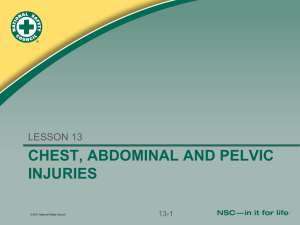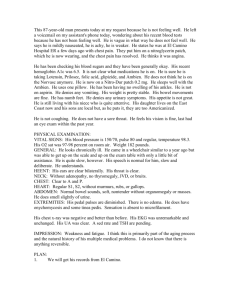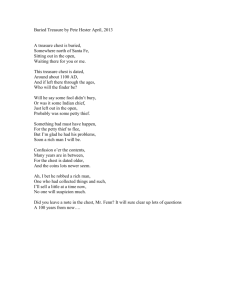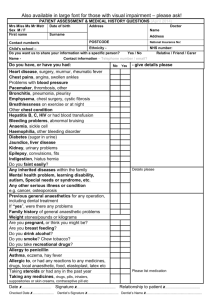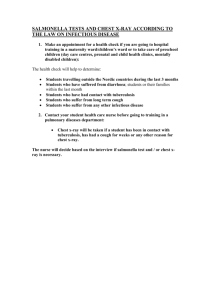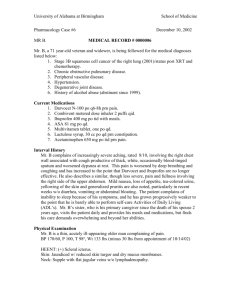Lesson 13: Chest, Abdominal, and Pelvic Injuries
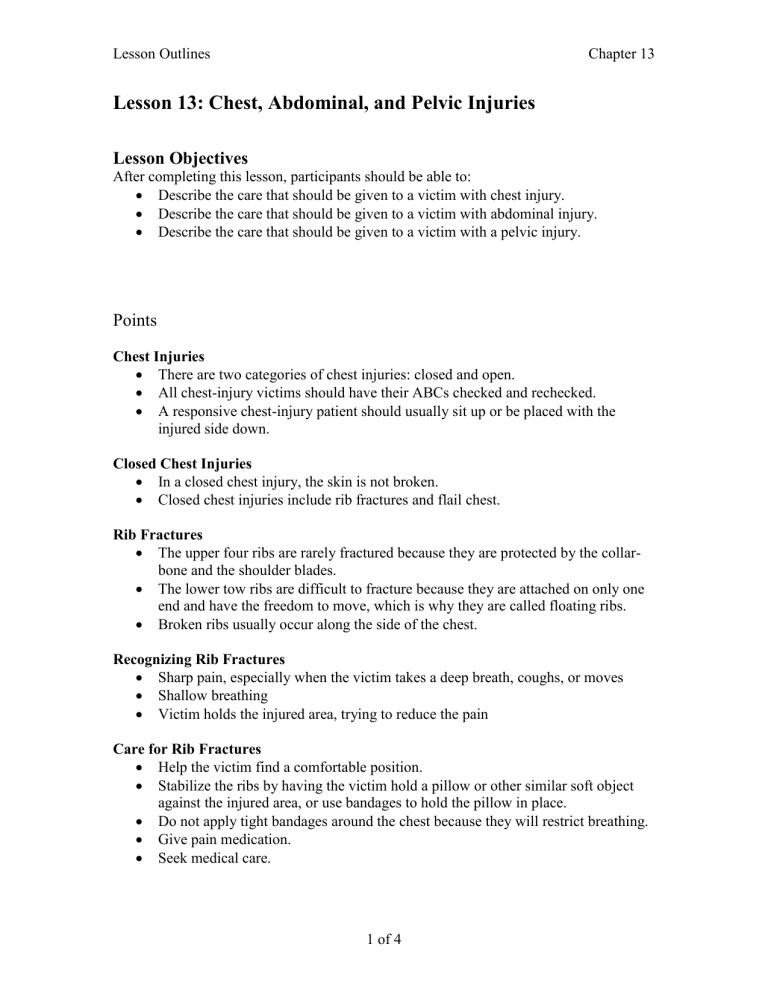
Lesson Outlines Chapter 13
Lesson 13: Chest, Abdominal, and Pelvic Injuries
Lesson Objectives
After completing this lesson, participants should be able to:
Describe the care that should be given to a victim with chest injury.
Describe the care that should be given to a victim with abdominal injury.
Describe the care that should be given to a victim with a pelvic injury.
Points
Chest Injuries
There are two categories of chest injuries: closed and open.
All chest-injury victims should have their ABCs checked and rechecked.
A responsive chest-injury patient should usually sit up or be placed with the injured side down.
Closed Chest Injuries
In a closed chest injury, the skin is not broken.
Closed chest injuries include rib fractures and flail chest.
Rib Fractures
The upper four ribs are rarely fractured because they are protected by the collarbone and the shoulder blades.
The lower tow ribs are difficult to fracture because they are attached on only one end and have the freedom to move, which is why they are called floating ribs.
Broken ribs usually occur along the side of the chest.
Recognizing Rib Fractures
Sharp pain, especially when the victim takes a deep breath, coughs, or moves
Shallow breathing
Victim holds the injured area, trying to reduce the pain
Care for Rib Fractures
Help the victim find a comfortable position.
Stabilize the ribs by having the victim hold a pillow or other similar soft object against the injured area, or use bandages to hold the pillow in place.
Do not apply tight bandages around the chest because they will restrict breathing.
Give pain medication.
Seek medical care.
1 of 4
Lesson Outlines Chapter 13
Flail Chest
A flail chest is a serious injury that involves several ribs in the same area broken in more than one place.
This injury is very painful and makes breathing difficult.
Recognizing Flail Chest
Paradoxical chest motion takes place o The area over the injury may move in a direction opposite to that of the rest of the chest wall during breathing.
Breathing is very difficult and painful.
Bruising of the skin over the injury occurs
Care for Flail Chest
Support the chest by one of several methods: o Apply hand pressure.
This is useful for a short time. o Place the victim on the injured side with a blanket or clothing underneath.
Monitor breathing.
Seek medical care.
Open Chest Injuries
In an open chest injury, the skin has been broken and the chest wall is penetrated by an object such as a knife or bullet.
Impaled Object in the Chest
If an object penetrates the chest wall, air and blood escape into the space between the lungs and the chest wall.
The air and blood cause the lung to collapse.
Recognizing Impaled Objects
An impaled object is usually easily recognized. o However, in some cases the object may be below the skin surface and is difficult to see.
Carefully look at wounds that could be hiding the object that caused the damage.
Care for an Impaled Object in the Chest
Stabilize the object in place with bulky dressings.
Do not try to remove the object. o Doing so can result in bleeding and air in the chest cavity.
Call 9-1-1.
2 of 4
Lesson Outlines Chapter 13
Sucking Chest Wound
A sucking chest wound results when a chest wound allows air to pass into and out of the chest with each breath.
Recognizing a Sucking Chest Wound
Blood bubbling out of chest wound
Sound of air being sucked in and out of chest wound
Care for a Sucking Chest Wound
Seal open wound with plastic wrap, if available.
Tape on three sides.
If victim has difficulty breathing, remove cover to let air escape, and reapply.
Call 9-1-1.
Abdominal Injuries
Abdominal injuries are either open or closed and can involve hollow and/or solid organs.
An internal abdominal injury is one of the most frequently unrecognized injuries.
When missed, it becomes one of the main causes of death.
Closed Abdominal Injuries
Closed abdominal injuries occur when the internal abdominal tissues are damaged but the skin is unbroken.
o Also known as blunt injuries
Bruising and damage to internal organs can result from a severe blow to the abdomen.
Recognizing a Closed Abdominal Injury
Examine the abdomen by gently pressing all four quadrants of the abdomen with your fingertips. o A normal abdomen is soft and not tender when pressed.
Signs of a closed abdominal injury include: o Bruises or other marks o Pain, tenderness, muscle tightness, or rigidity
Care for a Closed Abdominal Injury
Place the victim in a comfortable position.
Care for shock.
Call 9-1-1.
Open Abdominal Injury
Open abdominal injuries are those in which the skin has been broken.
Also known as penetrating injuries o Examples include stab wounds and gunshot wounds
Always assume the worst—that internal organs have been damaged.
3 of 4
Lesson Outlines Chapter 13
Care for a Penetrating Wound
If the penetrating object is still in place, stabilize the object and control the bleeding by placing bulky dressings around it.
Do not try to remove the object.
Call 9-1-1.
Impaled Object
Care is the same for an impaled object in the abdomen as it is for an impaled object in the chest.
Recognizing a Protruding Organ
A protruding organ injury refers to a severe injury to the abdomen in which internal organs escape or protrude from the wound.
Care for Protruding Organs
Call 9-1-1.
Allow the victim to stay in a comfortable position with the legs pulled up toward the abdomen.
Cover the protruding organs with a moist sterile dressing or clean cloth.
Treat for shock.
Pelvic Injuries
Pelvic injuries are usually caused by falling or a motor vehicle crash
Signs of a pelvic injury include: o Pain in hip, groin, or back that increases with movement o Inability to walk or stand o Signs of shock
Care for Pelvic Injuries
Treat the victim for shock.
Place padding between the victim’s thighs, and then tie the victim’s knees and ankles together. o If the knees are bent, place padding under them for support.
Keep the victim on a firm surface.
Call 9-1-1.
4 of 4
